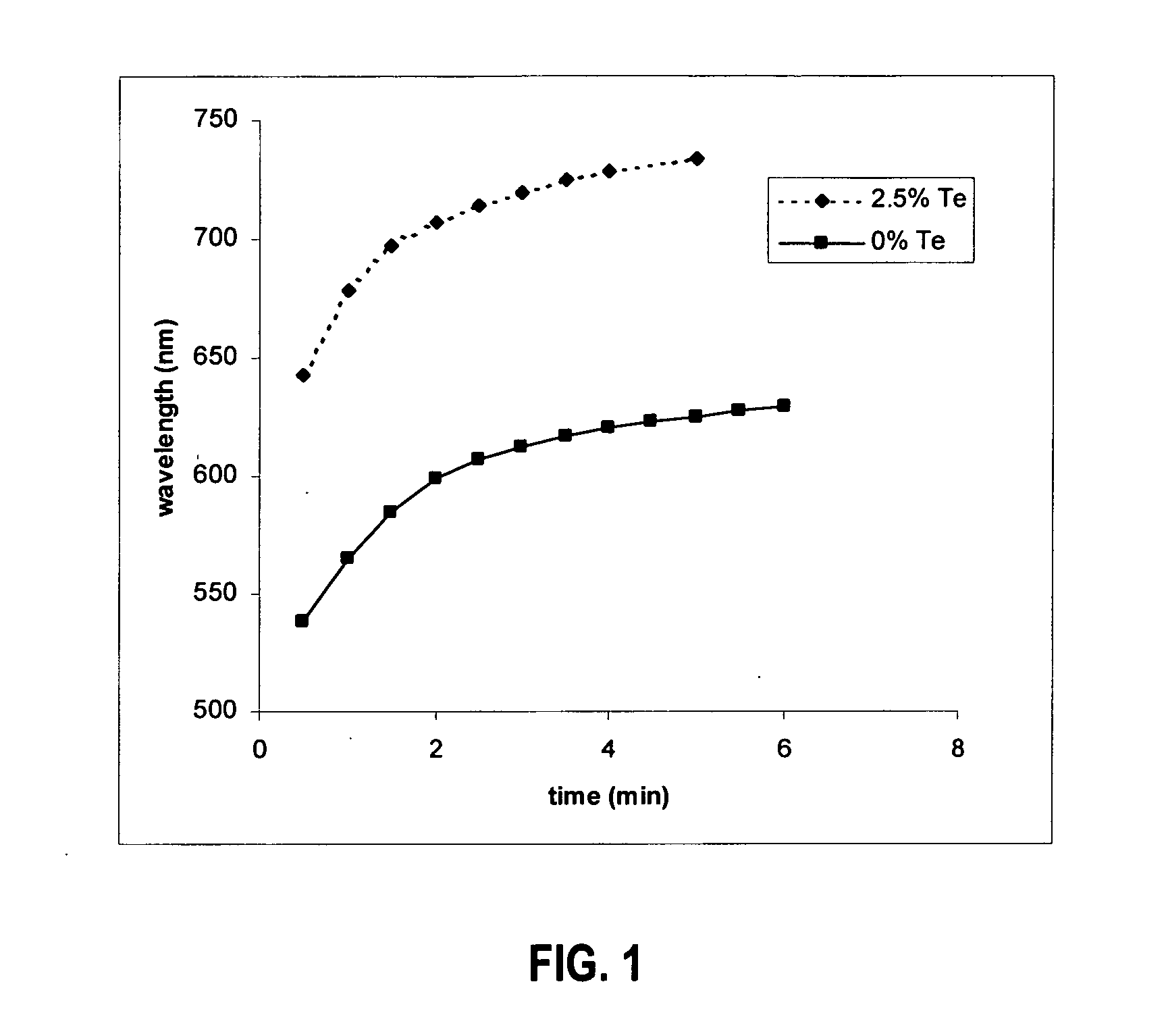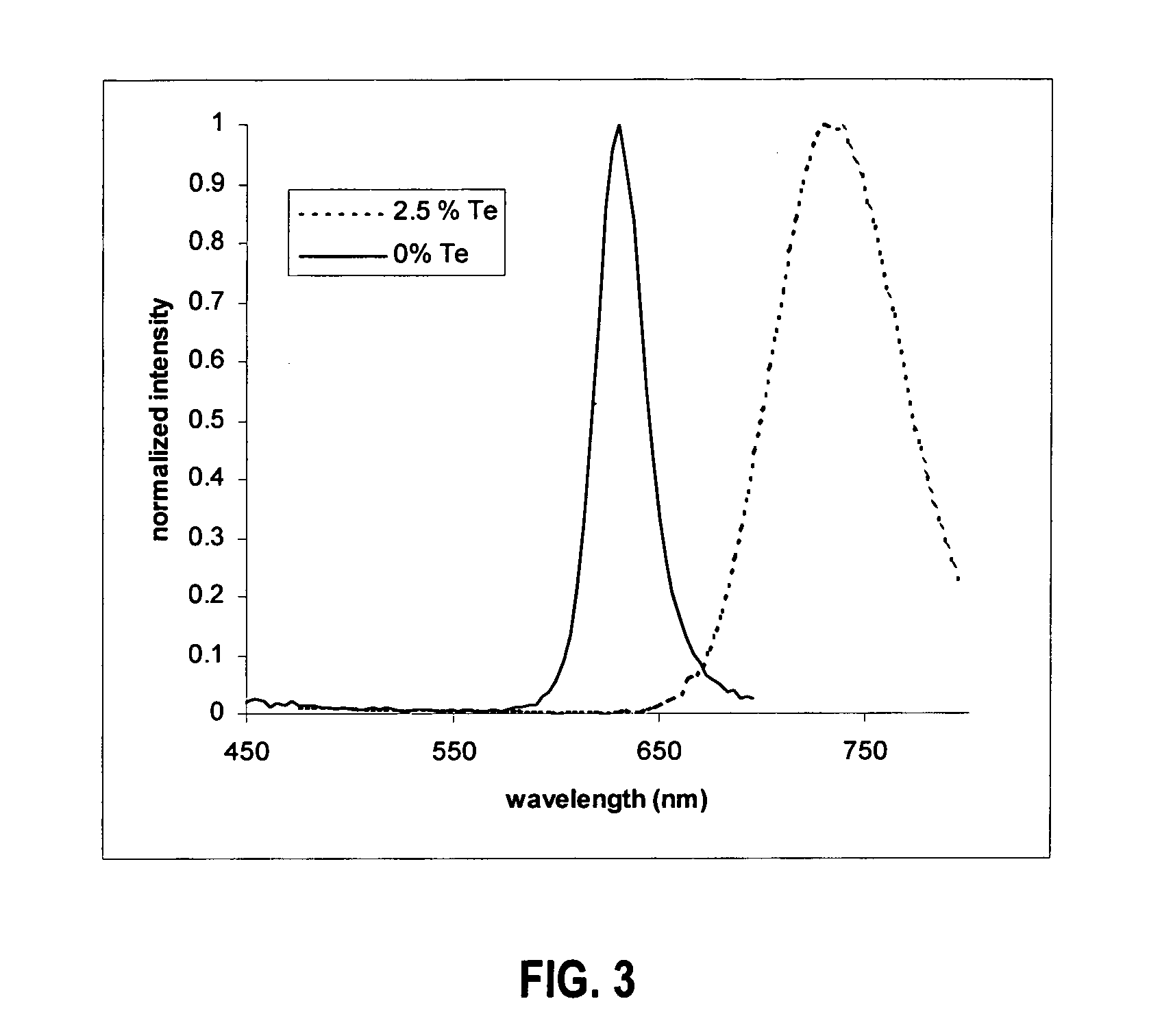Preparation of stable, bright luminescent nanoparticles having compositionally engineered properties
a technology of luminescent nanoparticles and composition engineered properties, which is applied in the field of luminescent nanoparticles, can solve the problems of low energy emission and achieve the effect of not increasing the size of nanoparticles or significantly changing the composition
- Summary
- Abstract
- Description
- Claims
- Application Information
AI Technical Summary
Benefits of technology
Problems solved by technology
Method used
Image
Examples
example 1
[0075] Synthesis of mixed cadmium, selenium, tellurium nanocrystalline cores:
[0076] TDPA (0.549 g), TOPO (6.000 g), and a magnetic stir bar were added to a clean, dry 50 mL three-neck round bottom flask. Port 1 of the flask was equipped with a gas inlet adapter to allow for evacuation and nitrogen refill, port 2 was equipped with a temperature probe attached to a temperature control device, and port 3 was fitted with a rubber septum. The flask was evacuated, refilled with nitrogen gas, and maintained under a nitrogen blanket. TOP (3.6 μL) and 1.972 g of Cd-TOP solution (containing cadmium acetate dissolved in TOP at a concentration of 0.5 moles of cadmium per kg solution) were added. A needle was inserted into the septum on port 3. The mixture was heated to 260° C. and held at that temperature for 20 minutes. The needle was removed and the reaction flask was heated to 355° C. During this heating step, diphenylphosphine (0.030 mL) was added, and at 340° C., a solution of 0.035 mL of...
example 2
[0079] Synthesis of mixed cadmium, selenium, tellurium nanocrystalline cores with passivating overlayer:
[0080] TOPO (3.383 g) and a magnetic stir bar were added to a 50 mL three-neck round bottom flask. Ports 1, 2, and 3 were capped as described in Example 1. The flask was evacuated and refilled with nitrogen gas. Under vacuum and with constant stirring, the TOPO was heated to 180° C. for 1 hour. The flask was refilled with nitrogen gas and allowed to cool to 100° C. before TOP (3.4 mL) was added. Ethanol (21.3 mL) and a sample of the cores prepared in Example 1 (10.7 mL warmed to 50° C.) were added to a 60 mL centrifuge tube. The mixture was centrifuged, the supernatant was discarded, and the pellet was redispersed in hexanes. The dispersion was then added to the reaction flask at 100° C. A vacuum was applied to remove the hexanes leaving the nanocrystals dispersed in TOPO and TOP. Decylamine (2.8 mL) was added to the reaction flask. In a second flask, a mixture of 3.905 g of Cd-T...
example 3
[0083] Evaluation of Quantum Yield:
[0084] The nanoparticles prepared in Example 2 were modified as described in U.S. Pat. No. 6,649,139 to Adams et al. to prepare the particles for dispersal in an aqueous solvent system, as follows.
[0085] (a) Synthesis of hydrophobically modified hydrophilic polymers for attachment to the nanoparticle surface:
[0086] A modified polyacrylic acid was prepared by diluting 100 g [0.48 mol COONa] of poly(acrylic acid, sodium salt) (obtained from Aldrich, molecular weight 1200) two-fold in water and acidifying in a 1.0 L round bottom flask with 150 ml (1.9 mol) of concentrated HCl. The acidified polymer solution was concentrated to dryness on a rotary evaporator (100 mbar, 80° C.). The dry polymer was evacuated for 12 hours at 2, and fit with a balloon. 500 ml of anhydrous N,N-dimethylformamide (Aldrich) was transferred under positive pressure through a cannula to this mixture; and the flask was swirled gently to dissolve the solids. 32 ml (0.19 mol) of...
PUM
| Property | Measurement | Unit |
|---|---|---|
| molar ratio | aaaaa | aaaaa |
| molar ratio | aaaaa | aaaaa |
| peak emission wavelength λXA | aaaaa | aaaaa |
Abstract
Description
Claims
Application Information
 Login to View More
Login to View More - R&D
- Intellectual Property
- Life Sciences
- Materials
- Tech Scout
- Unparalleled Data Quality
- Higher Quality Content
- 60% Fewer Hallucinations
Browse by: Latest US Patents, China's latest patents, Technical Efficacy Thesaurus, Application Domain, Technology Topic, Popular Technical Reports.
© 2025 PatSnap. All rights reserved.Legal|Privacy policy|Modern Slavery Act Transparency Statement|Sitemap|About US| Contact US: help@patsnap.com



